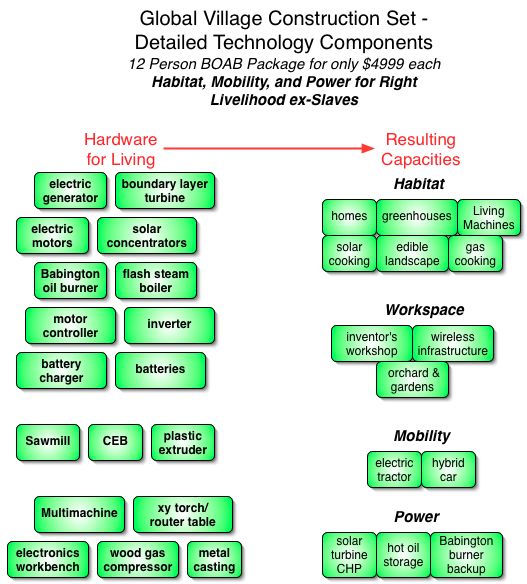Organizational Strategy
Introduction
Deployment of on-demand replicable right livelihood communities happens in 3 Phases:
- Pioneering life with deep exploration of useful technologies, to distill the essential from chaff. Status - in progress
- Replication as a 12 person, Buy Out At the Bottom (BOAB) Right Livelihood enterprise community (RLEC), where our notion of right livelihood includes priciples of open source economic development. This is an extension of the Hexayurt concept from the scale of emergency self-sustaining shelter to the scale of a landed, autonomous, small community with a sound economic base as part of the package. See details of the BOAB RLEC below.
- Internships at tha RLEC designed for immersion study to train others to replicate RLECs as a novel form of social organization.
Technology Base
Prerequisite technology for Phase 2 involves
- Necessary hardware for living - energy, food, housing, mobility, internet, workshop, orchard, etc.
- Social technology of gathering 12 people
- Land acquisition strategy built into the social technology.
Hardware for Living
The hardware for living includes:
The hardware involves:
- Electricity production - mainstay is solar concentrator power, with solar turbine electric power, Babington burner flash steam boiler backup, and heat storage via hot oil for cloudy periods up to 1 week. Inverters and battery storage is utilized. The hybrid car is also a high power mobile electric power plant also, and the electric tractor has batteries that may be tapped as well in emergencies.
- Food production - orchard, attached greenhouses, large-scale greenhouses, animal husbandry, aquaculture, and raised bed organoponics guarantee fresh foodstuffs. Solar dehydrators and canned food supplement the diet. Value added kitchen makes interesting food products.
- Housing - CEB, sawmill, and glazing extruder provide a solid basis for building homes, cisterns, silos, walls, paths, and other needs.
- Mobility - flex fab lab produces cars and tractors
- Wireless internet - hookup via existing service or wireless range extension.
Social Technology
The social technology involves collecting a group of 12 skilled individuals. These individuals agree to buy into creating the community under the guidance of the core organizer, at a cost of approximately $5k.
- Agricultural Producer - orchard, greenhouse, nursery, forestry, animal husbandry, vermiculture, fertilizer production - to feed the community and provide products for market
- Land Steward - responsible for maintainaining health of the land and sound developmenet practices for the facility
- Master Builder - an individual to lead construction efforts; also has architecture abilities
- Energy Provider - expert in renewable energy for autonomous energy, sales to the grid, excess fuel sales
- Healer - farmiliar with food as medicine, mind-body practice, massage, neutraceuticals, herbs, and basic first aid, and is on call to the rest of the community
- IT Provider - manages the computer and connectivity infrastructure
- Electronics Person - familiarity with computer control, automation, sensing, device controls, electronic devices, etc.
- Inventors - interesting products that contribute to a better world, not making a living; products include vehicles, energy systems, machines, and other devices; large market opportunities via open source flexible production, starting with power, habitat, mobility, and food needs of local communities
The group works together to make habitat, power, mobility, and right livelihood infrastructure for itself. This is immersion experience in self-sufficient living.
The work load should be approximately 2 hours per person per day to meet economic self-sufficiency and provide basic needs. On top of the 2 hours, it is total self-motivated productivity for individual needs and service to local communities. This is our idea of highest quality of life, where survival is a nominal endeavor, and the focus of one's life shifts to good work. A good level of flexible specialization makes the living situation comfortable to all, as the workload of surviving is not onerous to any one person.
Land Acquisition
Land is the largest expenditure for a community. As such, the number one approach to this issue is to seek someone who is already a landowner, and invite them into the program with their financial contribution replaced by the in-kind contribution of approximately $100k in land value. This value corresponds to the actual worth that each person is contributing: $5k in captital and $95k in skill offered to the community in the coming few years. Right livelihood opportunity cannot be matched to a price, but here we select $100k as a reasonable figure. This should procure from 5-50 acres of land. This land becomes part of the permanent stewartship holdings of the group, bound as a reserve to all future pursuers of right livelihood. Such land is not to enter the speculative market under any circumstances. In future years, additional members may enter the community, up to the number self-supported by the land base. This applies a natural bound for population control, where the limit is determined by optimal quality of life of existing members.
Priorities:
- Open Source Solar turbine, potential components
- Babington burner - http://www.green-trust.org/2000/biofuel/babington/default.htm
- Flash boiler -
- Solar concentrators - similar to http://www.redrok.com/images/hdsolar.jpg but mounted on flat panels for simplicity; check pricing estimates from http://www.hdsolar.com/ and compare to $100/KW thermal capture predictions by OSE
- Boundary Layer Turbine - http://openfarmtech.org/index.php?title=Solar_Turbine_CHP_System#Component_Design_-_Boundary_Layer_Turbine_.28BLT.29
- Generator heads - not much available, but check out http://www.scoraigwind.com/axialplans/index.htm
Outcomes:
- commercial product via open source, distributed, flexible fabrication, at absolute lowest cost, $1/W
Means:
- fabrication optimization, and product in kit for user assembly
Other priorities:
- CEB
- Sawmill
- Multimachine - http://opensourcemachine.org/
- CNC control
- Electric motor
